Related Research Articles

The gross domestic product (GDP) of Niger was $16.617 billion US dollars in 2023, according to official data from the World Bank. This data is based largely on internal markets, subsistence agriculture, and the export of raw commodities: foodstuffs to neighbors and raw minerals to world markets. Niger, a landlocked West African nation that straddles the Sahel, has consistently been ranked on the bottom of the Human Development Index, at 0.394 as of 2019. It has a very low per capita income, and ranks among the least developed and most heavily indebted countries in the world, despite having large raw commodities and a relatively stable government and society not currently affected by civil war or terrorism. Economic activity centers on subsistence agriculture, animal husbandry, re-export trade, and export of uranium.

A drought is a period of drier-than-normal conditions. A drought can last for days, months or years. Drought often has large impacts on the ecosystems and agriculture of affected regions, and causes harm to the local economy. Annual dry seasons in the tropics significantly increase the chances of a drought developing and subsequent wildfires. Periods of heat can significantly worsen drought conditions by hastening evaporation of water vapour.
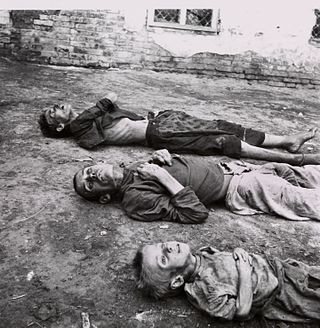
A famine is a widespread scarcity of food, caused by several factors including war, natural disasters, crop failure, widespread poverty, an economic catastrophe or government policies. This phenomenon is usually accompanied or followed by regional malnutrition, starvation, epidemic, and increased mortality. Every inhabited continent in the world has experienced a period of famine throughout history. During the 19th and 20th century, Southeast and South Asia, as well as Eastern and Central Europe, suffered the greatest number of fatalities. Deaths caused by famine declined sharply beginning in the 1970s, with numbers falling further since 2000. Since 2010, Africa has been the most affected continent in the world by famine.

The Green Revolution, also known as the Third Agricultural Revolution, was a period of technology transfer initiatives that saw greatly increased crop yields and agricultural production. These changes in agriculture began in developed countries after World War II and spread globally till the late 1980s. In the late 1960s, farmers began incorporating new technologies such as high-yielding varieties of cereals, particularly dwarf wheat and rice, and the widespread use of chemical fertilizers, pesticides, and controlled irrigation.
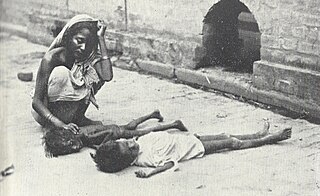
The Bengal famine of 1943 was a famine in the Bengal province of British India during World War II. An estimated 800,000 to 3.8 million Bengalis perished, out of a population of 60.3 million, from starvation, malaria and other diseases aggravated by malnutrition, population displacement, unsanitary conditions and lack of health care due to a combination of factors, including government policies, war-time disruption of food distribution, and high cyclones and floods. Millions were impoverished as the crisis overwhelmed large segments of the economy and catastrophically disrupted the social fabric. Eventually, families disintegrated; men sold their small farms and left home to look for work or to join the British Indian Army, and women and children became homeless migrants, often travelling to Calcutta or other large cities in search of organised relief. Some scholars characterise the famine as anthropogenic (man-made), asserting that wartime colonial policies exacerbated the crisis. Others argue that the famine was the result of natural causes.
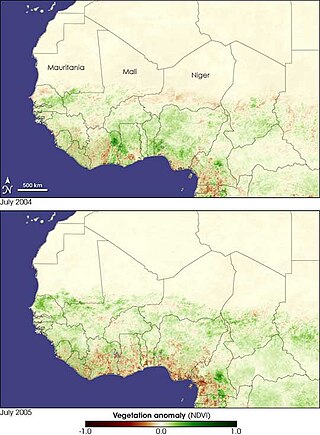
The 2005–2006 Niger food crisis was a severe but localized food security crisis in the regions of northern Maradi, Tahoua, Tillabéri, and Zinder of Niger from 2005 to 2006. It was caused by an early end to the 2004 rains, desert locust damage to some pasture lands, high food prices, and chronic poverty. In the affected area, 2.4 million of 3.6 million people are considered highly vulnerable to food insecurity. An international assessment stated that, of these, over 800,000 face extreme food insecurity and another 800,000 in moderately insecure food situations are in need of aid.
Famine scales are the ways in which degrees of food security are measured, from situations in which an entire population has adequate food to full-scale famine. The word "famine" has highly emotive and political connotations and there has been extensive discussion among international relief agencies offering food aid as to its exact definition. For example, in 1998, although a full-scale famine had developed in southern Sudan, a disproportionate amount of donor food resources went to the Kosovo War. This ambiguity about whether or not a famine is occurring, and the lack of commonly agreed upon criteria by which to differentiate food insecurity has prompted renewed interest in offering precise definitions. As different levels of food insecurity demand different types of response, there have been various methods of famine measurement proposed to help agencies determine the appropriate response.
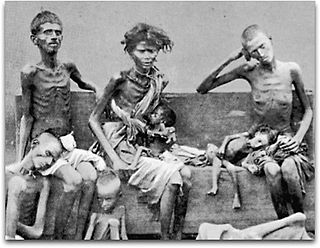
Famine had been a recurrent feature of life in the South Asian subcontinent countries of India and Bangladesh, most notoriously under British rule. Famines in India resulted in more than 30 million deaths over the course of the 18th, 19th, and early 20th centuries. Famines in British India were severe enough to have a substantial impact on the long-term population growth of the country in the 19th and early 20th centuries.

The Great Bengal famine of 1770 was a famine that struck Bengal and Bihar between 1769 and 1770 and affected some 30 million people. It occurred during a period of dual governance in Bengal. This existed after the East India Company had been granted the diwani, or the right to collect revenue in Bengal by the Mughal emperor in Delhi, but before it had wrested the nizamat, or control of civil administration, which continued to lie with the Mughal governor, the Nawab of Bengal Nazm ud Daula (1765-72).
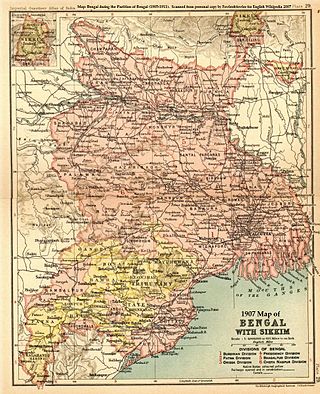
The Orissa famine of 1866 affected the east coast of India from Madras northwards, an area covering 180,000 miles and containing a population of 47,500,000; the impact of the famine, however, was greatest in the region of Orissa, now Odisha, which at that time was quite isolated from the rest of India. In Odisha, the total number who died as a result of the famine was at least a million, roughly one third of the population.

The timeline of major famines in India during British rule covers major famines on the Indian subcontinent from 1765 to 1947. The famines included here occurred both in the princely states, British India and Indian territories independent of British rule such as the Maratha Empire.

The Great Famine of 1876–1878 was a famine in India under Crown rule. It began in 1876 after an intense drought resulted in crop failure in the Deccan Plateau. It affected south and Southwestern India—the British-administered presidencies of Madras and Bombay, and the princely states of Mysore and Hyderabad—for a period of two years. In 1877, famine came to affect regions northward, including parts of the Central Provinces and the North-Western Provinces, and a small area in Punjab. The famine ultimately affected an area of 670,000 square kilometres (257,000 sq mi) and caused distress to a population totalling 58,500,000. The excess mortality in the famine has been estimated in a range whose low end is 5.6 million human fatalities, high end 9.6 million fatalities, and a careful modern demographic estimate 8.2 million fatalities. The famine is also known as the Southern India famine of 1876–1878 and the Madras famine of 1877.

The Indian famine of 1896–1897 was a famine that began in Bundelkhand, India, early in 1896 and spread to many parts of the country, including the United Provinces, the Central Provinces and Berar, Bihar, parts of the Bombay and Madras presidencies, and parts of the Punjab; in addition, the princely states of Rajputana, Central India Agency, and Hyderabad were affected. All in all, during the two years, the famine affected an area of 307,000 square miles (800,000 km2) and a population of 69.5 million. Although relief was offered throughout the famine-stricken regions in accordance with the Provisional Famine Code of 1883, the mortality, both from starvation and accompanying epidemics, was very high: approximately one million people are thought to have died.

The Indian famine of 1899–1900 began with the failure of the summer monsoons in 1899 over Western and Central India and, during the next year, affected an area of 476,000 square miles (1,230,000 km2) and a population of 59.5 million. The famine was acute in the Central Provinces and Berar, the Bombay Presidency, the minor province of Ajmer-Merwara, and the Hissar District of the Punjab; it also caused great distress in the princely states of the Rajputana Agency, the Central India Agency, Hyderabad and the Kathiawar Agency. In addition, small areas of the Bengal Presidency, the Madras Presidency and the North-Western Provinces were acutely afflicted by the famine.

Maharaja Sir Lakshmeshwar Singh, Maharaja of Darbhanga was the Zamindar and principal landowner of Darbhanga in the Mithila region, presently in the State of Bihar, India. His philanthropic works, administrative abilities and management of his estate were highly appreciated and lead to development of his estate.
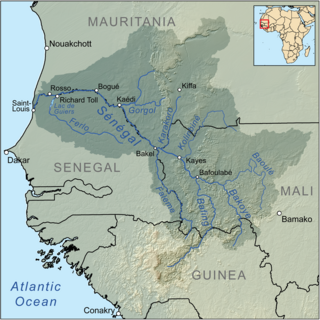
A large-scale, drought-induced famine occurred in Africa's Sahel region and many parts of the neighbouring Sénégal River Area from February to August 2010. It is one of many famines to have hit the region in recent times.
Inflation rate in India was 5.5% as of May 2019, as per the Indian Ministry of Statistics and Programme Implementation. This represents a modest reduction from the previous annual figure of 9.6% for June 2011. Inflation rates in India are usually quoted as changes in the Wholesale Price Index (WPI), for all commodities.
The 2013 drought in Maharashtra in India came about after the region received lower rainfall during the monsoon season June to September 2012. It is considered as the region's worst drought in 40 years. The worst-hit areas in Maharashtra were Solapur, Parbhani, Ahmednagar, Latur, Pune, Satara, Beed and Nashik. Residents of Latur, Osmanabad, Nanded, Aurangabad, Jalna, Jalgaon and Dhule districts were also affected by this famine.
Disaster management in India — policies, laws, routines, and courses-of-action to aid in the conservation and recovery of lives and property during a natural or man-made disaster. Disaster management plans are multi-layered, and are planned to address issues such as floods, hurricanes/cyclones, fire, mass failure of utilities (blackouts) and the rapid spread of disease (pandemic).
From a meteorological standpoint, India is especially vulnerable to natural disasters due to its unique location below the Himalayas as well as its geo-climatic conditions and varied landscapes; monsoons, subsequent landslides and floods, droughts, famine, wildfires, cyclones, and earthquakes are all experienced to varying degrees on the Subcontinent, in addition to areas of dense overpopulation being at greater risk for disease outbreak and sanitation concerns, in the event of a natural disaster.
Due to this vastness of the country, different regions are vulnerable to different natural disasters. For example, during monsoon season, it is the peninsular regions of South India that are generally most affected, as well as by cyclone or tsunami; the more temperate to arid states of western India risk severe drought, famine and/or wildfire during summer. The more remote, mountainous regions of the North, especially the Himalayan states, can experience devastating avalanches in winter, spring flooding and major landslides during wet periods. This is in addition to earthquakes which, in the mountains, bring the potential for increased devastation due to falling rocks, mudslides, and flash floods.

Nuclear famine is a hypothesized famine considered a potential threat following global or regional nuclear exchange. It is thought that even subtle cooling effects resulting from a regional nuclear exchange could have a substantial impact on agriculture production, triggering a food crisis amongst the world's survivors.
References
- 1 2 Brennan, L (1984), "The development of the India Famine Codes: personalities, policies and politics", in Currey, Bruce; Hugo, Graeme (eds.), Famine as a geographical phenomenon, GeoJournal library, vol. 1 (Illustrated ed.), Springer, pp. 91–110, ISBN 90-277-1762-1
- ↑ "Retrospective determination of whether famine existed in Niger", Field Exchange, ENN, no. 35, p. 10, March 2009, archived from the original on September 7, 2010, retrieved October 11, 2009Summary of published research:Reza, Avid; Tomczyk, Basia; Aguayo, Victor M; Zagré, Noel M; Goumbi, Kadadé; Blanton, Curtis; Talley, Leisel (2008). "Retrospective determination of whether famine existed in Niger, 2005: two stage cluster survey". BMJ. 337: a1622. doi:10.1136/bmj.a1622. PMC 2658864 . PMID 18832413.
- ↑ "Historical responses to famine". Encyclopædia Britannica Online. Retrieved 8 October 2009.